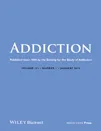 Accueil
Accueil
Détail de l'auteur
Auteur T. NORSTROM |
Documents disponibles écrits par cet auteur (5)
 Ajouter le résultat dans votre panier Faire une suggestion Affiner la recherche
Ajouter le résultat dans votre panier Faire une suggestion Affiner la recherche
Article : Périodique
Aims: To estimate whether parental socio-economic status (SES) is associated with adolescent drinking, and the degree to which a possible association may be accounted for by various parental factors. Design and setting: Cross-sectional Norwegia[...]
Article : Périodique
Background: Several components of the Swedish alcohol policy, e.g., pricing and availability, weakened when Sweden joined the EU in 1995. To counteract the possible negative effects of this, emphasis was placed on the local level as an important[...]
Article : Périodique
INTRODUCTION: To explore whether Skog's theory of collectivity of drinking cultures is valid across groups with different socioeconomic position (SEP). METHODS: Individual-level information on alcohol consumption and SEP for the years 2004-2014[...]
Article : Périodique
Aims: To estimate the relationship between per capita alcohol consumption and youth drinking in Sweden during the last 40 years and to estimate the relationship between female and male youth drinking during the 40-year study period. Design, set[...]
Article : Périodique
INTRODUCTION AND AIMS: Research based on individual-level data suggests that the same amount of alcohol yields more harm in low-socioeconomic status (SES) groups than in high-SES groups. Little is known whether the effect of changes in populatio[...]




